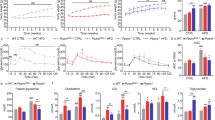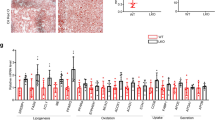Abstract
Peroxisome proliferator-activated receptor-γ (PPARγ) is a transcription factor that regulates lipid metabolism and inflammatory responses. Certain PPARγ ligands improve nonalcoholic steatohepatitis (NASH). The role of PPARγ itself in NASH remains poorly understood. The functional consequences of PPARγ in the development of steatohepatitis through gene deficiency or gene overexpression of PPARγ delivered by adenovirus (Ad-PPARγ) were examined. Our results show that PPARγ-deficient (PPARγ+/−) mice fed the methionine- and choline-deficient (MCD) diet developed more severe steatohepatitis than wild-type mice, and were unaffected by PPARγ ligand rosiglitazone. Overexpression of PPARγ delivered by Ad-PPARγ attenuated steatohepatitis. This effect was associated with redistribution of fatty acid from liver to adipose tissue by enhancing expression of fatty acid uptake genes (fatty acid binding protein-4 (aP2), fatty acid translocase (CD36), lipoprotein lipase (LPL) and fatty acid transport protein-1 (FATP-1)) and lipogenic genes (sterol regulatory element binding protein isoform-1 (SREBP-1) and stearoyl-CoA desaturase isoform-1 (SCD-1)) in adipose tissue and to a lesser extent in liver. The anti-steatohepatitis action of PPARγ was also mediated via regulating adipokines through suppressing tumor necrosis factor-α (TNF-α) and interleukin-6 (IL-6) and inducing adiponectin. Moreover, PPARγ activation suppressed hepatic lipoperoxide and reduced hepatic pro-inflammatory cytokines (TNF-α and IL-6) production. In conclusion, PPARγ is an important endogenous regulator and potential therapeutic target for nutritional steatohepatitis.
This is a preview of subscription content, access via your institution
Access options
Subscribe to this journal
Receive 12 print issues and online access
$259.00 per year
only $21.58 per issue
Buy this article
- Purchase on Springer Link
- Instant access to full article PDF
Prices may be subject to local taxes which are calculated during checkout






Similar content being viewed by others
Abbreviations
- ALT:
-
alanine aminotransferase
- aP2:
-
fatty acid binding protein-4
- FATP:
-
fatty acid transport protein
- CD36:
-
fatty acid translocase
- LPL:
-
lipoprotein lipase
- MCD:
-
methionine and choline deficient
- NASH:
-
nonalcoholic steatohepatitis
- PPARγ:
-
peroxisome proliferator-activated receptor-γ
- SCD-1:
-
stearoyl-CoA desaturase isoform-1
- SREBP-1:
-
sterol regulatory element binding protein isoform-1
- TG:
-
triglyceride
- WAT:
-
white adipose tissue
- TNF-α:
-
tumor necrosis factor-α
- IL-6:
-
interleukin-6
References
Chawla A, Schwarz EJ, Dimaculangan DD, Lazar MA . Peroxisome proliferator-activated receptor (PPAR) gamma: adipose-predominant expression and induction early in adipocyte differentiation. Endocrinology 1994; 135: 798–800.
Jay MA, Ren J . Peroxisome proliferator-activated receptor (PPAR) in metabolic syndrome and type 2 diabetes mellitus. Curr Diabetes Rev 2007; 3: 33–39.
Belfort R, Harrison SA, Brown K, Darland C, Finch J, Hardies J et al. A placebo-controlled trial of pioglitazone in subjects with nonalcoholic steatohepatitis. N Engl J Med 2006; 355: 2297–2307.
Lutchman G, Modi A, Kleiner DE, Promrat K, Heller T, Ghany M et al. The effects of discontinuing pioglitazone in patients with nonalcoholic steatohepatitis. Hepatology 2007; 46: 424–429.
Caldwell SH, Argo CK . Divergent effects of peroxisome proliferator-activated receptor-gamma ligands in human and mouse nonalcoholic steatohepatitis. Hepatology 2007; 46: 285–287.
Yu J, Ip E, Dela Pena A, Hou JY, Sesha J, Pera N et al. COX-2 induction in mice with experimental nutritional steatohepatitis: role as pro-inflammatory mediator. Hepatology 2006; 43: 826–836.
The Jackson Laboratory. Technical document 006142. Available at http://jaxmice.jax.org/strain/006142.htmlAccessed April 2008.
Okuno A, Tamemoto H, Tobe K, Ueki K, Mori Y, Iwamoto K et al. Troglitazone increases the number of small adipocytes without the change of white adipose tissue mass in obese Zucker rats. J Clin Invest 1998; 101: 1354–1361.
Yamauchi T, Kamon J, Waki H, Murakami K, Motojima K, Komeda K et al. The mechanisms by which both heterozygous peroxisome proliferator-activated receptor gamma (PPARgamma) deficiency and PPARgamma agonist improve insulin resistance. J Biol Chem 2001; 276: 41245–41254.
García-Ruiz I, Rodríguez-Juan C, Díaz-Sanjuán T, Martínez MA, Muñoz-Yagüe T, Solís-Herruzo JA . Effects of rosiglitazone on the liver histology and mitochondrial function in ob/ob mice. Hepatology 2007; 46: 414–423.
Yu S, Matsusue K, Kashireddy P, Cao WQ, Yeldandi V, Yeldandi AV et al. Adipocyte-specific gene expression and adipogenic steatosis in the mouse liver due to peroxisome proliferator-activated receptor gamma1 (PPARgamma1) overexpression. J Biol Chem 2003; 278: 498–505.
Evans RM, Barish GD, Wang YX . PPARs and the complex journey to obesity. Nat Med 2004; 10: 355–361.
Chabowski A, Zmijewska M, Gorski J, Bonen A, Kamiñski K, Winnicka MM . Effect of IL-6 deficiency on myocardial expression of fatty acid transporters and intracellular lipid deposits.J Physiol Pharmacol 2007; 58: 73–82.
Al-Hasani H, Joost HG . Nutrition-/diet-induced changes in gene expression in white adipose tissue. Best Pract Res Clin Endocrinol Metab 2005; 19: 589–603.
Yki-Jarvinen H . Thiazolidinediones. N Engl J Med 2004; 351: 1106–1118.
Ip E, Farrell G, Hall P, Robertson G, Leclercq I . Administration of the potent PPARalpha agonist, Wy-14 643, reverses nutritional fibrosis and steatohepatitis in mice. Hepatology 2004; 39: 1286–1296.
Xu A, Wang Y, Keshaw H, Xu LY, Lam KS, Cooper GJ . The fat-derived hormone adiponectin alleviates alcoholic and nonalcoholic fatty liver diseases in mice. J Clin Invest 2003; 112: 91–100.
Tilg H, Diehl AM . Cytokines in alcoholic and nonalcoholic steatohepatitis. N Engl J Med 2000; 343: 1467–1476.
Kugelmas M, Hill DB, Vivian B, Marsano L, McClain CJ . Cytokines and NASH: a pilot study of the effects of lifestyle modification and vitamin E. Hepatology 2003; 38: 413–419.
Lago F, Dieguez C, Gomez-Reino J, Gualillo O . Adipokines as emerging mediators of immune response and inflammation. Nat Clin Pract Rheumatol 2007; 3: 716–724.
Wong VW, Hui AY, Tsang SW, Chan JL, Tse AM, Chan KF . Metabolic and adipokine profile of Chinese patients with nonalcoholic fatty liver disease. Clin Gastroenterol Hepatol 2006; 4: 1154–1161.
Kadowaki T, Yamauchi T . Adiponectin and adiponectin receptors. Endocr Rev 2005; 26: 439–451.
Pradhan AD, Manson JE, Rifai N, Buring JE, Ridker PM . C-reactive protein, interleukin 6, and risk of developing type 2 diabetes mellitus. JAMA 2001; 286: 327–334.
Senn JJ, Klover PJ, Nowak IA, Mooney RA . Interleukin-6 induces cellular insulin resistance in hepatocytes. Diabetes 2002; 51: 3391–3399.
Guilherme A, Virbasius JV, Puri V, Czech MP . Adipocyte dysfunctions linking obesity to insulin resistance and type 2 diabetes. Nat Rev Mol Cell Biol 2008; 9: 367–377.
Henriksen JH, Tronier B, Bulow JB . Kinetics of circulating endogenous insulin, C-peptide, and proinsulin in fasting nondiabetic man. Metabolism 1987; 36: 463–468.
Farrell GC . Non-alcoholic steatohepatitis: what is it, and why is it important in the Asia-Pacific region? J Gastroenterol Hepatol 2003; 18: 124–138.
Shen B, Yu J, Wang S, Chu ES, Wong VW, Zhou X et al. Phyllanthus urinaria ameliorates the severity of nutritional steatohepatitis both in vitro and in vivo. Hepatology 2008; 47: 473–483.
Jiang C, Ting AT, Seed B . PPAR-gamma agonists inhibit production of monocyte inflammatory cytokines. Nature 1998; 391: 82–86.
Guan HP, Li Y, Jensen MV, Newgard CB, Steppan CM, Lazar MA . A futile metabolic cycle activated in adipocytes by antidiabetic agents. Nat Med 2002; 8: 1122–1128.
Akiyama TE, Sakai S, Lambert G, Nicol CJ, Matsusue K, Pimprale S et al. Conditional disruption of the peroxisome proliferator-activated receptor gamma gene in mice results in lowered expression of ABCA1, ABCG1, and apoE in macrophages and reduced cholesterol efflux. Mol Cell Biol 2002; 22: 2607–2619.
Nicol CJ, Yoon M, Ward JM, Yamashita M, Fukamachi K, Peters JM et al. PPARgamma influences susceptibility to DMBA-induced mammary, ovarian and skin carcinogenesis. Carcinogenesis 2004; 25: 1747–1755.
Acknowledgements
This project was funded by a Research Grants Council Competitive Earmarked Research Grants CUHK 478207 and CUHK478108.
Author information
Authors and Affiliations
Corresponding author
Ethics declarations
Competing interests
The authors declare no conflict of interest.
Additional information
Supplementary Information accompanies the paper on Gene Therapy website
Supplementary information
Rights and permissions
About this article
Cite this article
Wu, C., Chu, E., Lam, C. et al. PPARγ is essential for protection against nonalcoholic steatohepatitis. Gene Ther 17, 790–798 (2010). https://doi.org/10.1038/gt.2010.41
Received:
Revised:
Accepted:
Published:
Issue Date:
DOI: https://doi.org/10.1038/gt.2010.41
Keywords
This article is cited by
-
The Elk-3 target Abhd10 ameliorates hepatotoxic injury and fibrosis in alcoholic liver disease
Communications Biology (2023)
-
Selection and Characterization of Probiotic Bacteria Exhibiting Antiadipogenic Potential in 3T3-L1 Preadipocytes
Probiotics and Antimicrobial Proteins (2022)
-
Hepatoprotective effect of Qushihuayu formula on non-alcoholic steatohepatitis induced by MCD diet in rat
Chinese Medicine (2021)
-
Regulation of peroxisome proliferator-activated receptor-gamma activity affects the hepatic stellate cell activation and the progression of NASH via TGF-β1/Smad signaling pathway
Journal of Physiology and Biochemistry (2021)
-
Antiobesity Effect of Novel Probiotic Strains in a Mouse Model of High-Fat Diet–Induced Obesity
Probiotics and Antimicrobial Proteins (2021)



